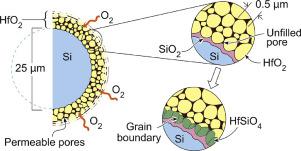当前位置:
X-MOL 学术
›
Acta Mater.
›
论文详情
Our official English website, www.x-mol.net, welcomes your
feedback! (Note: you will need to create a separate account there.)
Hafnium silicate formation during oxidation of a permeable silicon + HfO2 powder composite system
Acta Materialia ( IF 8.3 ) Pub Date : 2020-12-01 , DOI: 10.1016/j.actamat.2020.10.019 Jeroen A. Deijkers , Haydn N.G. Wadley
Acta Materialia ( IF 8.3 ) Pub Date : 2020-12-01 , DOI: 10.1016/j.actamat.2020.10.019 Jeroen A. Deijkers , Haydn N.G. Wadley

|
Abstract Silicon bond coats, applied to silicon carbide composites used in gas turbine engines as a part of an environmental barrier coating (EBC) system, arrest the transport of oxidizing species to the SiC composite by forming a SiO2 thermally grown oxide. Above 1200°C, a crystalline s-cristobalite SiO2 phase is formed that subsequently undergoes a large thermal contraction during its s→α-cristobalite transformation upon cooling, leading to oxide layer cracking and eventual EBC delamination. A model system of silicon particles in a highly porous HfO2 particle matrix is used to investigate the rate and mechanism by which s-cristobalite SiO2 is dynamically converted to hafnium orthosilicate (HfSiO4; Hafnon) when oxidizing silicon is in contact with m-HfO2. The study compares the net rate of SiO2 formation in the model silicon + HfO2 system with that on only silicon particles, and finds that the thickness of the SiO2 layer that forms during high temperature (1250–1316°C) oxidation can be greatly reduced by the hafnon formation reaction. The study also investigates the mechanism by which hafnon forms, and reports a SiO2 rumpling process when its outward (radial) growth is locally constrained by HfO2 particles. Since hafnon is phase stable over the temperature range of EBC interest, and has a thermal expansion coefficient similar to silicon, the dynamic conversion of SiO2 to hafnon provides a promising approach for controlling the delamination of EBC systems that use silicon bond coats.
中文翻译:

可渗透硅 + HfO2 粉末复合体系氧化过程中形成硅酸铪
摘要 硅结合涂层作为环境屏障涂层 (EBC) 系统的一部分应用于燃气涡轮发动机中使用的碳化硅复合材料,通过形成 SiO2 热生长氧化物阻止氧化物质向 SiC 复合材料的传输。高于 1200°C,形成结晶 s-方石英 SiO2 相,随后在其 s→α-方石英转变过程中在冷却时经历大的热收缩,导致氧化层开裂和最终的 EBC 分层。高度多孔 HfO2 颗粒基质中的硅颗粒模型系统用于研究氧化硅与 m-HfO2 接触时 s-方石英 SiO2 动态转化为原硅酸铪(HfSiO4;Hafnon)的速率和机制。该研究比较了模型硅 + HfO2 系统中 SiO2 形成的净速率与仅在硅颗粒上形成的净速率,发现高温(1250-1316°C)氧化过程中形成的 SiO2 层的厚度可以通过以下方式大大降低哈夫农形成反应。该研究还调查了哈夫农形成的机制,并报告了当其向外(径向)生长受到 HfO2 颗粒局部约束时的 SiO2 起皱过程。由于 hafnon 在 EBC 感兴趣的温度范围内是相稳定的,并且具有与硅相似的热膨胀系数,SiO2 到 hafnon 的动态转化为控制使用硅粘合涂层的 EBC 系统的分层提供了一种很有前途的方法。并发现在高温(1250-1316°C)氧化过程中形成的 SiO2 层的厚度可以通过铪形成反应大大降低。该研究还调查了哈夫农形成的机制,并报告了当其向外(径向)生长受到 HfO2 颗粒局部约束时的 SiO2 起皱过程。由于 hafnon 在 EBC 感兴趣的温度范围内是相稳定的,并且具有与硅相似的热膨胀系数,SiO2 到 hafnon 的动态转化为控制使用硅粘合涂层的 EBC 系统的分层提供了一种很有前途的方法。并发现在高温(1250-1316°C)氧化过程中形成的 SiO2 层的厚度可以通过铪形成反应大大降低。该研究还调查了哈夫农形成的机制,并报告了当其向外(径向)生长受到 HfO2 颗粒局部约束时的 SiO2 起皱过程。由于 hafnon 在 EBC 感兴趣的温度范围内是相稳定的,并且具有与硅相似的热膨胀系数,SiO2 到 hafnon 的动态转化为控制使用硅粘合涂层的 EBC 系统的分层提供了一种很有前途的方法。并报告了当 SiO2 向外(径向)生长受到 HfO2 颗粒局部限制时的 SiO2 起皱过程。由于 hafnon 在 EBC 感兴趣的温度范围内是相稳定的,并且具有与硅相似的热膨胀系数,SiO2 到 hafnon 的动态转化为控制使用硅粘合涂层的 EBC 系统的分层提供了一种很有前途的方法。并报告了当 SiO2 向外(径向)生长受到 HfO2 颗粒局部限制时的 SiO2 起皱过程。由于 hafnon 在 EBC 感兴趣的温度范围内是相稳定的,并且具有与硅相似的热膨胀系数,SiO2 到 hafnon 的动态转化为控制使用硅粘合涂层的 EBC 系统的分层提供了一种很有前途的方法。
更新日期:2020-12-01
中文翻译:

可渗透硅 + HfO2 粉末复合体系氧化过程中形成硅酸铪
摘要 硅结合涂层作为环境屏障涂层 (EBC) 系统的一部分应用于燃气涡轮发动机中使用的碳化硅复合材料,通过形成 SiO2 热生长氧化物阻止氧化物质向 SiC 复合材料的传输。高于 1200°C,形成结晶 s-方石英 SiO2 相,随后在其 s→α-方石英转变过程中在冷却时经历大的热收缩,导致氧化层开裂和最终的 EBC 分层。高度多孔 HfO2 颗粒基质中的硅颗粒模型系统用于研究氧化硅与 m-HfO2 接触时 s-方石英 SiO2 动态转化为原硅酸铪(HfSiO4;Hafnon)的速率和机制。该研究比较了模型硅 + HfO2 系统中 SiO2 形成的净速率与仅在硅颗粒上形成的净速率,发现高温(1250-1316°C)氧化过程中形成的 SiO2 层的厚度可以通过以下方式大大降低哈夫农形成反应。该研究还调查了哈夫农形成的机制,并报告了当其向外(径向)生长受到 HfO2 颗粒局部约束时的 SiO2 起皱过程。由于 hafnon 在 EBC 感兴趣的温度范围内是相稳定的,并且具有与硅相似的热膨胀系数,SiO2 到 hafnon 的动态转化为控制使用硅粘合涂层的 EBC 系统的分层提供了一种很有前途的方法。并发现在高温(1250-1316°C)氧化过程中形成的 SiO2 层的厚度可以通过铪形成反应大大降低。该研究还调查了哈夫农形成的机制,并报告了当其向外(径向)生长受到 HfO2 颗粒局部约束时的 SiO2 起皱过程。由于 hafnon 在 EBC 感兴趣的温度范围内是相稳定的,并且具有与硅相似的热膨胀系数,SiO2 到 hafnon 的动态转化为控制使用硅粘合涂层的 EBC 系统的分层提供了一种很有前途的方法。并发现在高温(1250-1316°C)氧化过程中形成的 SiO2 层的厚度可以通过铪形成反应大大降低。该研究还调查了哈夫农形成的机制,并报告了当其向外(径向)生长受到 HfO2 颗粒局部约束时的 SiO2 起皱过程。由于 hafnon 在 EBC 感兴趣的温度范围内是相稳定的,并且具有与硅相似的热膨胀系数,SiO2 到 hafnon 的动态转化为控制使用硅粘合涂层的 EBC 系统的分层提供了一种很有前途的方法。并报告了当 SiO2 向外(径向)生长受到 HfO2 颗粒局部限制时的 SiO2 起皱过程。由于 hafnon 在 EBC 感兴趣的温度范围内是相稳定的,并且具有与硅相似的热膨胀系数,SiO2 到 hafnon 的动态转化为控制使用硅粘合涂层的 EBC 系统的分层提供了一种很有前途的方法。并报告了当 SiO2 向外(径向)生长受到 HfO2 颗粒局部限制时的 SiO2 起皱过程。由于 hafnon 在 EBC 感兴趣的温度范围内是相稳定的,并且具有与硅相似的热膨胀系数,SiO2 到 hafnon 的动态转化为控制使用硅粘合涂层的 EBC 系统的分层提供了一种很有前途的方法。









































 京公网安备 11010802027423号
京公网安备 11010802027423号